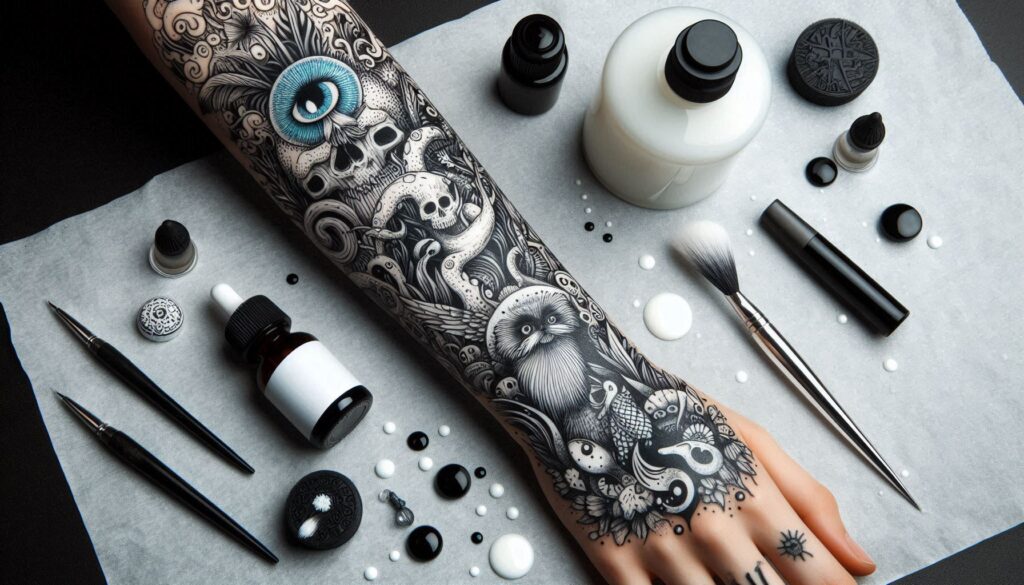The Pros and Cons of White Ink Tattoos: What Australians Need to Know
In the colorful world of tattoo artistry, white ink tattoos represent a unique and intriguing option. While traditional tattoos typically use bold colors and dark outlines, white ink tattoos offer a subtler, almost ethereal aesthetic. This trend has been gaining traction among Australians who are looking for something distinct from the mainstream. However, before you decide to go under the needle for a white ink tattoo, it’s crucial to weigh the pros and cons to ensure it’s the right choice for you. Let’s explore what makes white ink tattoos stand out and what potential challenges they might present.

What Are White Ink Tattoos?
White ink tattoos are exactly what they sound like—tattoos created using white ink. Unlike traditional tattoos that rely on a spectrum of colors, white ink tattoos use a single pigment to create designs. This unique approach results in a tattoo that often appears more subtle and less pronounced than its colorful counterparts.
White ink tattoos can vary greatly in appearance depending on several factors:
- Skin Tone: The visibility and appearance of white ink tattoos can differ based on your skin tone. On lighter skin, white ink tends to be more visible and stands out well. On darker skin tones, white ink may appear more subdued and might not be as vibrant.
- Tattoo Design: The design of a white ink tattoo can significantly affect its outcome. Intricate and detailed designs may show up better, while simpler patterns might blend more with the skin. The texture and contrast of the design play crucial roles in how the final tattoo looks.
- Healing and Maintenance: White ink tattoos can change in appearance over time due to healing and skin regeneration. The ink may settle into the skin differently than colored inks, leading to variations in how the tattoo looks after it’s healed.
Pros of White Ink Tattoos
- Subtlety and Elegance: One of the main advantages of white ink tattoos is their subtlety. These tattoos often blend seamlessly with the skin, creating a more delicate and understated look. This can be perfect for individuals who want a tattoo that is more personal and less conspicuous.
- Unique Aesthetic: White ink tattoos offer a distinctive aesthetic that sets them apart from traditional tattoos. Their sheer, almost ghostly appearance can be particularly striking, making them a popular choice for those seeking a unique and modern tattoo style.
- Minimalist Appeal: For fans of minimalist art, white ink tattoos can provide a clean and minimalist look. They often complement simple, geometric designs or delicate line work, aligning well with contemporary and minimalist art trends.
- Less Painful: Some people report that white ink tattoos are less painful compared to traditional tattoos. This might be due to the different application process and the fact that white ink often requires fewer layers of ink to achieve the desired effect.
- Good for Cover-Ups: White ink can be used effectively for cover-up tattoos. It can work as a base layer to mask old tattoos, providing a blank canvas for new designs. This technique allows for the transformation of an old tattoo into something new and fresh.
Cons of White Ink Tattoos
- Visibility Issues: One of the main drawbacks of white ink tattoos is their visibility. On darker skin tones, white ink might not be as noticeable, and the tattoo could appear more subdued. Even on lighter skin, the visibility of white ink can vary based on how well the ink settles and heals.
- Fading Over Time: White ink tattoos are known for their tendency to fade faster than traditional tattoos. The ink can break down more quickly under UV exposure and general wear and tear, requiring touch-ups to maintain its appearance.
- Healing Challenges: White ink tattoos can sometimes pose more significant healing challenges compared to other tattoo colors. They may take longer to heal, and there is a risk of the ink not settling evenly, which can affect the overall appearance of the tattoo.
- Limited Color Options: The use of white ink limits the color palette available for tattoo designs. While white ink can be used to create striking contrasts, it doesn’t offer the same range of colors and hues as traditional tattoo inks.
- Higher Risk of Infection: Some people find that white ink tattoos are more prone to infection and complications. The delicate nature of the ink and the application process can sometimes lead to issues during healing. Proper aftercare is essential to mitigate this risk.
- Artist Expertise: Not all tattoo artists are experienced with white ink tattoos. Finding an artist skilled in this particular style is crucial to achieving the best results. An inexperienced artist might not be able to execute the design effectively, leading to unsatisfactory outcomes.

Choosing the Right Design
The design of a white ink tattoo plays a crucial role in its success. Here are some design tips to consider:
- Simple and Detailed: White ink works well with both simple and detailed designs. Intricate patterns and fine lines can create beautiful and subtle effects, while minimalist designs can highlight the elegant nature of the white ink.
- Contrasts and Highlights: Consider incorporating contrasting elements or highlights in your design. White ink can be used to create a sense of depth and dimension, making certain parts of the tattoo stand out more effectively.
- Test Runs: If you’re unsure about how white ink will look on your skin, consider starting with a small test area. This can give you an idea of how the ink settles and whether it suits your skin tone and design preference.
Aftercare for White Ink Tattoos
Proper aftercare is essential to ensure that your white ink tattoo heals well and maintains its appearance. Here are some aftercare tips specific to white ink tattoos:
- Keep It Clean: Gently wash the tattooed area with a mild, fragrance-free soap and lukewarm water. Avoid scrubbing or using harsh chemicals that could irritate the skin.
- Moisturize Regularly: Apply a thin layer of tattoo aftercare ointment or a fragrance-free moisturizer to keep the tattoo hydrated. This helps in the healing process and can prevent the tattoo from drying out and fading prematurely.
- Avoid Sun Exposure: Protect your tattoo from direct sunlight and UV exposure, as this can cause the white ink to fade more quickly. Once healed, use sunscreen to protect your tattoo and maintain its color.
- Follow Artist’s Instructions: Your tattoo artist will provide specific aftercare instructions. Follow these carefully to ensure that your tattoo heals properly and that the white ink remains vibrant.
- Monitor for Complications: Keep an eye on the healing process for any signs of infection or complications. If you notice unusual redness, swelling, or discharge, contact your tattoo artist or a healthcare professional for advice.
Conclusion
White ink tattoos offer a unique and elegant alternative to traditional tattoo styles, with their own set of benefits and challenges. In Australia, where tattoo culture is vibrant and diverse, white ink tattoos are gaining popularity for their subtlety and distinctive appearance. However, it’s important to consider the potential drawbacks, such as visibility issues and fading, before committing to this style.

If you’re intrigued by the idea of a white ink tattoo and want to explore this trend further, Tattoos Down Under offers expert tattooing services that can help you achieve your vision. Their skilled artists can guide you through the process, ensuring that your white ink tattoo is executed with precision and care, resulting in a beautiful and lasting piece of art.


Leave a Reply